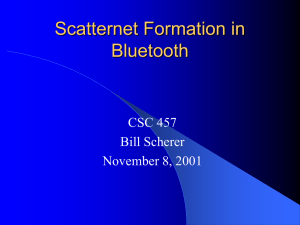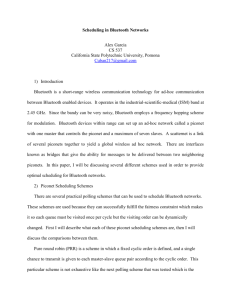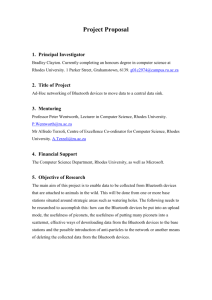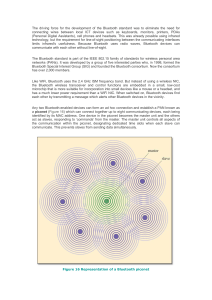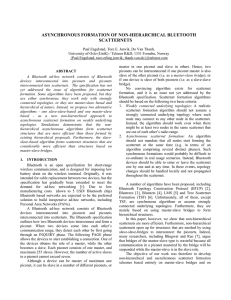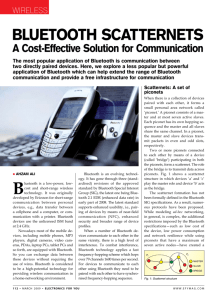FORMATION OF SCATTERNETS WITH HETEROGENEOUS BLUETOOTH DEVICES
advertisement
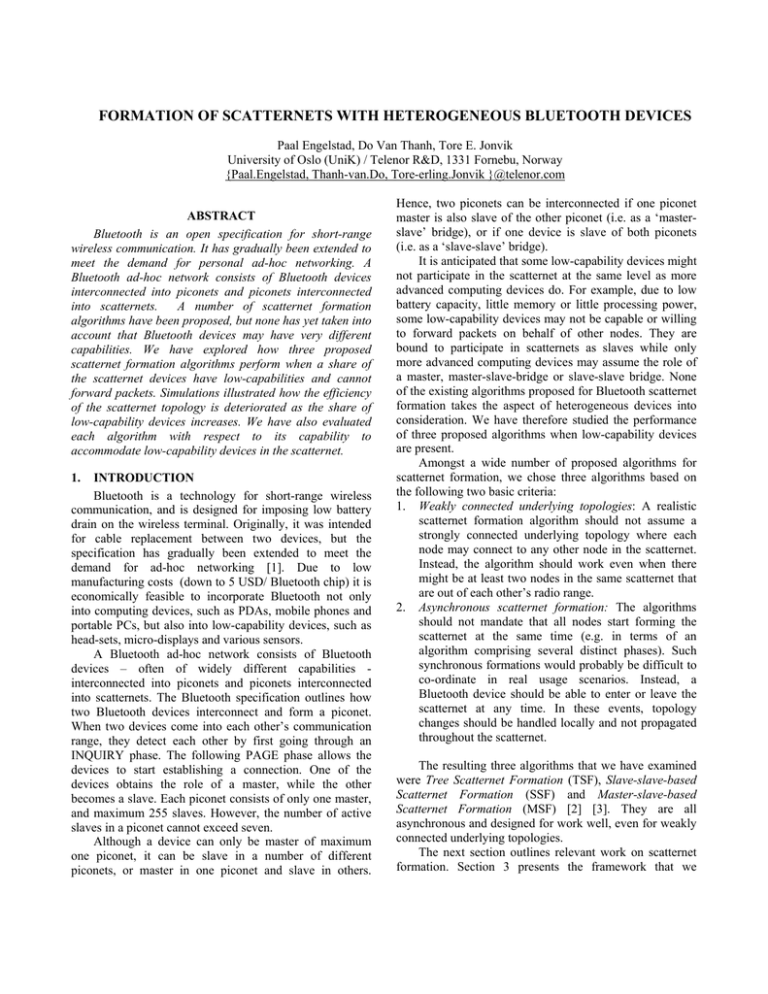
FORMATION OF SCATTERNETS WITH HETEROGENEOUS BLUETOOTH DEVICES
Paal Engelstad, Do Van Thanh, Tore E. Jonvik
University of Oslo (UniK) / Telenor R&D, 1331 Fornebu, Norway
{Paal.Engelstad, Thanh-van.Do, Tore-erling.Jonvik }@telenor.com
ABSTRACT
Bluetooth is an open specification for short-range
wireless communication. It has gradually been extended to
meet the demand for personal ad-hoc networking. A
Bluetooth ad-hoc network consists of Bluetooth devices
interconnected into piconets and piconets interconnected
into scatternets.
A number of scatternet formation
algorithms have been proposed, but none has yet taken into
account that Bluetooth devices may have very different
capabilities. We have explored how three proposed
scatternet formation algorithms perform when a share of
the scatternet devices have low-capabilities and cannot
forward packets. Simulations illustrated how the efficiency
of the scatternet topology is deteriorated as the share of
low-capability devices increases. We have also evaluated
each algorithm with respect to its capability to
accommodate low-capability devices in the scatternet.
1.
INTRODUCTION
Bluetooth is a technology for short-range wireless
communication, and is designed for imposing low battery
drain on the wireless terminal. Originally, it was intended
for cable replacement between two devices, but the
specification has gradually been extended to meet the
demand for ad-hoc networking [1]. Due to low
manufacturing costs (down to 5 USD/ Bluetooth chip) it is
economically feasible to incorporate Bluetooth not only
into computing devices, such as PDAs, mobile phones and
portable PCs, but also into low-capability devices, such as
head-sets, micro-displays and various sensors.
A Bluetooth ad-hoc network consists of Bluetooth
devices – often of widely different capabilities interconnected into piconets and piconets interconnected
into scatternets. The Bluetooth specification outlines how
two Bluetooth devices interconnect and form a piconet.
When two devices come into each other’s communication
range, they detect each other by first going through an
INQUIRY phase. The following PAGE phase allows the
devices to start establishing a connection. One of the
devices obtains the role of a master, while the other
becomes a slave. Each piconet consists of only one master,
and maximum 255 slaves. However, the number of active
slaves in a piconet cannot exceed seven.
Although a device can only be master of maximum
one piconet, it can be slave in a number of different
piconets, or master in one piconet and slave in others.
Hence, two piconets can be interconnected if one piconet
master is also slave of the other piconet (i.e. as a ‘masterslave’ bridge), or if one device is slave of both piconets
(i.e. as a ‘slave-slave’ bridge).
It is anticipated that some low-capability devices might
not participate in the scatternet at the same level as more
advanced computing devices do. For example, due to low
battery capacity, little memory or little processing power,
some low-capability devices may not be capable or willing
to forward packets on behalf of other nodes. They are
bound to participate in scatternets as slaves while only
more advanced computing devices may assume the role of
a master, master-slave-bridge or slave-slave bridge. None
of the existing algorithms proposed for Bluetooth scatternet
formation takes the aspect of heterogeneous devices into
consideration. We have therefore studied the performance
of three proposed algorithms when low-capability devices
are present.
Amongst a wide number of proposed algorithms for
scatternet formation, we chose three algorithms based on
the following two basic criteria:
1. Weakly connected underlying topologies: A realistic
scatternet formation algorithm should not assume a
strongly connected underlying topology where each
node may connect to any other node in the scatternet.
Instead, the algorithm should work even when there
might be at least two nodes in the same scatternet that
are out of each other’s radio range.
2. Asynchronous scatternet formation: The algorithms
should not mandate that all nodes start forming the
scatternet at the same time (e.g. in terms of an
algorithm comprising several distinct phases). Such
synchronous formations would probably be difficult to
co-ordinate in real usage scenarios. Instead, a
Bluetooth device should be able to enter or leave the
scatternet at any time. In these events, topology
changes should be handled locally and not propagated
throughout the scatternet.
The resulting three algorithms that we have examined
were Tree Scatternet Formation (TSF), Slave-slave-based
Scatternet Formation (SSF) and Master-slave-based
Scatternet Formation (MSF) [2] [3]. They are all
asynchronous and designed for work well, even for weakly
connected underlying topologies.
The next section outlines relevant work on scatternet
formation. Section 3 presents the framework that we
http://folk.uio.no/paalee/
developed for the investigation of scatternets formation
with heterogeneous devices. Based on this framework, we
performed simulations. Simulation results are presented in
Section 4. Finally, we present the conclusions of our work
in Section 5.
2.
RELATED WORK
2.1. Bluetooth link formation
The link formation process is specified in the
Bluetooth baseband specification [1]. The link formation
comprises an Inquiry phase followed by a Page phase. In
both phases the hopping pattern is limited to 32 frequencies
(or only 16 frequencies in a few countries). The Inquiry
process allows a master node to discover and collect clock
and address information about neighboring devices. The
page process uses this information to establish a bidirectional frequency hopping communication channel.
master receives the response and establishes a connection
with the slave.
2.2. Related work on scatternet formation
Miklos et al. [4] undertook an early study on scatternet
formation. They used heuristics to generate scatternets with
some desirable properties, and evaluated them by means of
simulations. Johansson et al. [5] performed link-layer
simulations of piconets.
Later Salonidis et al. [6] presented a symmetric link
formation scheme where no configuration of potential
master or slave roles is necessary. Instead, each node
alternates between the INQUIRY and INQUIRY SCAN
states (Figure 2).
Figure 2. The symmetric link formation scheme proposed by Salonidis et
al. [6]
Figure 1. Connection State Diagram for Bluetooth link formation
During the Inquiry process a potential master (i.e. the
device to be the master of the connection to be formed) will
first have to enter the INQUIRY state, while a potential
slave will have to enter the INQUIRY SCAN state (Figure
1). A device in the former state alternates between
transmitting short identity-packets containing an Inquiry
Access Code (IAC) and listening for responses. A node in
the latter state, on the other hand, listens for packets from
devices in the INQUIRY state, performs an IAC check and
responds when appropriate with an Inquiry Response
Message containing the device address and other device
specific information.
Once the Inquiry is successful, the potential master
enters the PAGING state and tries to establish a connection
with the specified potential slave. Meanwhile, the potential
slave has shifted to the PAGE SCAN state. It receives a
Paging packet from the potential master and processes the
Device Access Code. If appropriate, it returns a response to
the master and finally enters the connection state. The
http://www.unik.no/personer/paalee
Using this scheme, they also proposed the Bluetooth
Topology Construction Protocol (BTCP) [6]. BTCP
comprise an initial procedure in which a scatternet leader is
first elected. The election phase means that BTCP is a
synchronous protocol (although devices are allowed to act
in a distributed fashion). The election algorithm also
requires a strongly connected underlying topology in which
each node is in direct communication distance with every
other node in the scatternet. After election, the elected
leader determines the scatternet topology and instructs
other devices on how to form the scatternet. As the
resulting topology is not detailed by the protocol, BTCP
represent an election protocol more than a complete
scatternet formation algorithm.
On the contrary, the Bluetree algorithm, proposed by
Zaruba et al. [7], assumes that a node knows a-priori
whether it is a scatternet leader (or ‘root’) or not. It then
uses some distributed spanning tree algorithms to form a
hierarchical scatternet tree of master-slave bridges rooted at
the scatternet leader. Since the root initiates the scatternet
formation while other devices must wait to be paged, the
formation algorithm is synchronous. However, unlike
BTCP, it does not require a strongly connected underlying
topology. Zaruba et al. also proposed to use slave-slave
bridges to interconnect different Bluetrees. Wang et al. [8]
go one step further and propose a non-hierarchical
(however, still synchronous) variation of Bluetrees.
Unlike the previous proposals, the LMS algorithm,
proposed by Law et al. [9] is an asynchronous approach in
which a scatternet is built as nodes join the scatternet tree,
and nodes can join anytime. The scatternet formation
overhead is kept to a minimum since one node is
designated the task to perform INQUIRY or INQUIRY
SCAN on behalf of the whole scatternet. However, this
scheme requires a strongly connected underlying topology.
Tan et al. [2] proposed the Tree Scatternet Formation
(TSF) algorithm. A hierarchical scatternet is formed
asynchronously as nodes join the tree. Unlike LMS, the
algorithm allows for a weakly connected underlying
topology of devices. Two trees may combine into one tree
as the roots of the trees get within communication range.
Neither LMS nor TSF require the aforementioned
symmetric link formation proposed by Salonidis et al. [6].
Finally, Engelstad et al. [3] proposed SSF and MSF as
non-hierarchical counterparts to TSF. In addition to being
asynchronous and accommodating weakly connected
underlying topology of devices, these algorithms also obey
two design principles targeted at enhancing the efficiency
of the resulting scatternet [3, 6, 8]:
a.
b.
Minimal Piconet Overlap: Two piconets should be
connected by at most one bridge node.
Minimal Bridge Degree: A bridge node should
participate in at most two piconets, i.e. each slaveslave bridge is slave of exactly two masters, while
each master-slave bridge is slave of exactly one other
master or master-slave.
Engelstad et al. [3] introduced a role-transition matrix
to describe state transitions of asynchronous scatternet
formation algorithms that are obeying the two
aforementioned design principles. At some point in time
every device starts out as a free node. A regular free node F
may then encounter and connect to another device.
Whether it becomes master (i.e. in role-state M) or slave
(i.e. in role-state S) depends on the role of the node it
connects to and can be read from the role-transition matrix
of the scatternet formation algorithm. When a slave or
master connects to a node of another piconet, it may obtain
an additional slave-role or master-role and become a bridge
between the two piconets. Whether it becomes a masterslave bridge (i.e. in role-state ms) or a slave-slave bridge
(i.e. in role-state ss) can also be found from the roletransition matrix. The ‘Maximum Bridge Degree’ design
principle prohibits that a node obtains more than two roles.
Thus, the upper part of the role-state diagram depicted in
Figure 6 describes how regular nodes participate in
scatternet formation [3].
An example of a role-transition matrix is shown in
Figure 3. It describes the transitions of the hierarchical TSF
algorithm. 'Before' refers to a node's state before
interconnection, while 'after' refers to the resulting state.
Note that if a node disconnects, on the other hand, the state
transition will go in the opposite direction.
Figure 3: Role-transition matrix for TSF. A more detailed matrix is
provided in [3].
Since MSF, unlike TSF, is not bound to the
hierarchical approach, a master is allowed to connect to
free nodes, slaves or master-slave bridges, resulting in
highly meshed scatternets. The latter connections always
produce master-slave bridges, and no slave-slave bridges.
The role-transition matrix of MSF is shown in Figure 4. It
differs from that of TSF in role-transitions 3, 8, 11, 12, 13
and 23.
Figure 4. Role-transition matrix for the MSF algorithm, which generates
only ms-bridges. The matrix is simplified by omitting transitions with an
ss-bridge in the initial state, since MSF results in scatternets without ssbridges.
SSF - in contrast to TSF and MSF - never produces
master-slave bridges in role-transitions 2, 6, 8 and 12. This
restriction means that unlike in MSF, masters in SSF have
no way of connecting to other masters or master-slaves, but
may connect to slaves. In this case, the connected master
remains a master, while the slave connected to becomes a
slave-slave bridge. The role-transition matrix of SSF is
shown in Figure 5.
Figure 5. Role-transition matrix for the SSF algorithm, which generates
only ss-bridges. The matrix has been simplified by omitting transitions
with an ms-bridge or an ss-bridge in the initial state.
How MSF and SSF are realized by using
INQUIRY/INQUIRY-SCAN and PAGE/PAGE-SCAN is
outlined in [3]. How TSF is realized is detailed in [2].
3.
A FRAMEWORK FOR HETEROGENEOUS
DEVICES
To explore the ability of a scatternet formation
algorithm to accommodate heterogeneous devices, we
assumed that a predefined share of the devices were of low
capabilities, and would only attach to scatternets as slaves.
Compared to the framework in [3], we introduced two new
roles; Low-capability Free node (lf) and Low-capability
Slave (ls).
A low-capability device starts out in the “Lowcapability Free” role-state (lf), while a high-capability
computing device, starts out in the regular free role state F.
When a Low-capability Free node lf encounters and
connects to another node, it can only assume the role of a
Low-capability Slave ls. A Low-capability Slave cannot
connect to other devices. The lower part of the role-state
diagram in Figure 6 illustrates how low-capability devices
participate in scatternet formation.
Figure 6: Role-state diagram for scatternet formation. (x represents the
role of the node connected to, i.e. x∈{F, M, M', S, ms, ms', ss, lf, ls}.
With two new roles, the role transition matrices in Figure
1, 2 and 3 must be expanded with additional transitions.
These additional transitions are shown in Figure 7.
Figure 7. Expanding the role-transition matrices by adding additional
transitions. For simplicity transitions with a Low-capability Slave (ls) or a
slave-slave (ss) in the initial state have been omitted.
Transition a of Figure 7 means that two Lowcapability Free nodes cannot interconnect because both
devices require to become slave of a connection. A Lowcapability Free node lf may, however, connect to a regular
high-capability node, and become a slave. Transitions b, c,
d and e show that the regular node connected to must
become master of the new connection. SSF does not
generate master-slave connections, and for this algorithm
lf-nodes are thus not allowed to connect to regular slaves
(transition c). For MSF and TSF, on the other hand, lfnodes can connect to regular slaves, which become masterslaves after the connection is set up.
Hence, with the link formation scheme proposed for
SSF and MSF in [3], lf-nodes will always go in INQUIRYSCAN, and will not alternate between INQUIRY and
INQUIRY-SCAN like regular free nodes.
4.
SIMULATIONS
4.1. Simulation setup
By simulations we placed Bluetooth devices in a 30mby-30m square. For simplicity, a node was allowed to
communicate with all other nodes located within 10m. This
is represented by arcs in the visibility graph as defined in
[4] It was not allowed to communicate with any nodes
outside this range.
Nodes were placed in an arbitrary position inside the
square, and they arrived one by one to a maximum of 40
nodes. Each arriving node was categorized either as a lowcapability node by a pre-determined probability P or as a
regular node (by probability 1-P). The arriving node
interacted with other nodes and scatternets already formed
within the square, while obeying the rules of the scatternet
formation algorithm simulated. The resulting scatternet
configuration was used as a starting point when the next
node arrived in the square. This simulation run was
repeated 100 times. Simulations were done using Matlab.
Upon the arrival of a node in the square, the arriving
node detected and started connecting to an arbitrary of its
neighboring nodes in accordance with the scatternet
formation algorithm. It continued detecting and connecting
to neighbors until it had tried connecting to all of its
neighbors.
4.2. Evaluation metrics
A number of different evaluation metrics can be used
to assess the capability of an algorithm to accommodate
heterogeneous devices [3]. Since the purpose of scatternet
formation is to ensure connectivity for communication
between devices, an overall goal is to maximize
connectivity. Connectivity is a particularly significant
evaluation parameter with the presence of low-capability
devices, because such devices may easily become
disconnected (e.g. if there are no masters or master-slaves
to connect to).
To maximize connectivity, an algorithm should
interconnect a given set of nodes into as few disconnected
scatternets, N, as possible. It is evident that the theoretical
lower limit, N0,, of the number of disconnected scatternets
formed by any algorithm, is found by traversing the
visibility graph, as defined in [4], instead of traversing the
links formed by the scatternet algorithm. Hence, the
connectivity-ratio, rconn, defined as
rconn = N/N0
(1)
gives a good measure of the overall connectivity provided
by the scatternet formation algorithm.
The same simulation configuration was run for all
algorithms under study, and the average connectivity ratio
was calculated for each algorithm and for each number of
nodes in the square.
A number of researchers emphasize that a low average
shortest path (ASP) of a scatternet indicates an efficient
scatternet topology ([3], [8]). The ASP-ratio is defined as
the ASP of a scatternet relative to the minimal ASP, ASP0:
rasp = ASP/ASP0
devices, a fully meshed slave-slave based algorithm (like
SSF) is preferable. The connectivity performance of SSF is
comparable with that of MSF for low node densities (i.e.
few nodes in Figure 8), and better for higher node
densities. (The advantages of a slave-slave-based approach
as compared to master-slave based algorithms are
explained further in [3].) TSF had considerably worse
connectivity ratio than both SSF and MSF, due to the
hierarchical nature of TSF.
We continued simulating scenarios with non-zero
probability P that an arriving node is a low-capability
device. Figure 9 and 10 show the result for P = .50 and P =
.75, respectively.
(2)
ASP is found by traversing the links formed by the
scatternet algorithm between the nodes only within one
disconnected scatternet. ASP0 is found by traversing the
links of the visibility graph between the same set of nodes.
4.3. Simulation Results
We performed a number of simulations scenarios, each
scenario characterized with a given probability, P, that an
arriving node would be a low-capability device. For each
scenario, we plotted the connectivity ratio to see how the
presence of low-capability devices influences scatternet
connectivity.
Figure 9. P = .50: With 50% low-capability devices, the slave-slave based
approach (SSF) still provides better connectivity than the master-slave
based approach (MSF). TSF is hardly capable to accommodate
heterogeneous devices due to its hierarchical nature.
Figure 8. P = 0: With only homogeneous devices, slave-slave based SSF
has better connectivity performance as compared to master-slave-based
MSF and TSF. (TSF is worse than MSF, mainly due to the hierarchical
tree structure that TSF requires.)
First we simulated a scenario with a probability of zero
that an arriving node would be a low-capability device.
This scenario corresponds to scatternet formation with
homogenous Bluetooth devices [3]. Indeed, Figure 8 shows
that the connectivity ratio is farther from the theoretical
optimal connectivity ratio of one. With no low-capability
Figure 10. P = .75: In the extreme case with 75% low-capability devices,
the slave-slave based approach (SSF) outperforms the master-slave based
approaches (MSF and TSF).
With an average 50% share of devices being of low
capability (Figure 9), the connectivity of MSF deteriorates
faster than that of SFF for low node densities (i.e. for few
number of nodes in Figure 9). For higher node densities
SSF deteriorates relatively faster than MSF, but not so
much that MSF is preferable. In total, SSF performs better
than MSF. We also observe that the strictly hierarchical
approach, TSF, is hardly capable of accommodating
heterogeneous devices, because a device that cannot
transform from slave to master-slave will clog the
hierarchical formation process.
As an extreme scenario, we tested an average share of
low-capability devices of 75% (Figure 10). We observed
that the performance of the meshed master-slave-based
MSF algorithm breaks down, while SSF on the contrary
performs surprisingly well.
We also found that with heterogeneous devices (P =
50%) there are no significant differences between the
average shortest path performances of the three algorithms
(Figure 11).
formation algorithm must create topologies that easily
accommodate connectivity for such devices. This is easily
measured by the connectivity ratio [3].
We simulated three proposed algorithms for Bluetooth
scatternet formation in different scenarios. Each scenario
had a different average share of low-capability devices.
TSF had little ability to accommodate low-capability
devices, because a low-capability device will clog the
hierarchical scatternet formation.
The non-hierarchical algorithms, on the other hand,
can be highly meshed, and rules to ensure a hierarchical
structure are not present. Hence, the non-hierarchical
algorithms showed considerably higher ability to
accommodate low-capability devices.
Of the non-hierarchal algorithms, the slave-slave based
scatternet formation scheme, SSF, outperformed the
scheme based on master-slave bridges, MSF. With no lowcapability devices, the SSF algorithm was preferable.
When we then added low-capability devices to the system,
the connectivity of MSF deteriorated faster than that of
SFF, and MSF gradually broke down. SSF on the other
hand, performed surprisingly well.
Hence, out of the three algorithms we studied, the nonhierarchical, fully meshed slave-slave based approach to
scatternet formation, SSF, were the only algorithm that was
capable of accommodating scatternet formation of
heterogeneous devices with acceptable performance.
REFERENCES
[1]
[2]
[3]
[4]
[5]
Figure 11. P = .50: There are few significant differences between TSF,
SSF and MSF with respect to the ASP-ratio.
5.
SUMMARY AND CONCLUSIONS
To our knowledge no work has yet been published on
scatternet formation with respect to heterogeneous devices,
although Bluetooth will be incorporated into devices of
widely different capabilities. We have therefore developed
a framework to investigate scatternet formation with
heterogeneous devices, and performed simulations based
on this framework.
The presence of low-capability devices will influence
the scatternet performance. When low-capability devices
will only participate as slaves in scatternets, the scatternet
[6]
[7]
[8]
[9]
“Specification of the Bluetooth System,” Bluetooth Special
Interest Group document, http://www.bluetooth.com/, Dec. 1999.
Tan et al., ”Forming Scatternets from Bluetooth Personal Area
Networks”, MIT Technical Report, MIT-LCS-TR-826,
http://nms.lcs.mit.edu/projects/blueware/body.htm, October 2001.
Engelstad et al., ”Asynchronous formation of non-hierarchical
Bluetooth scatternets“, to appear in proceedings of 3G Wireless
Conference 2003, In Press.
Miklos et al., ”Performance Aspects of Bluetooth Scatternet
Formation”, MobiHoc 2000, pp147-148, June 2001.
Johansson et al., ”Short-range radio based ad-hoc networking:
performance and properties”. In Proceedings of the IEEE
International Conference on Communications 1999, vol. 3,
pp.1414-1420, 1999.
Salonidis et al. ”Proximity Awareness and Ad Hoc Network
Establishment in Bluetooth”, Technical Research Report,
http://www.isr.umd.edu/CSHCN, 2001.
Zaruba, G.V., Basagni, S., Chlamtac, I., “Bluetrees – Scatternet
Formation to Enable Bluetooth-Based Ad Hoc Networks”, In
Proceedings of the IEEE International Conference on
Communications (ICC) 2001, Helsinki, Finland, June 2001.
Wang, Z., Thomas, R.J., Haas, Z., “Bluenet – a New Scatternet
Formation Scheme”, 35th Hawaii International Conference on
System Science (HICSS-35), Big Island Hawaii, January 7-10,
2002.
Law, C., Mehta, A.K., Sui, K. -Y., “Performance of a New
Bluetooth Scatternet Formation Protocol”, In Proc. of the ACM
Symposium on Mobile Ad Hoc Networking and Computing
(MobiHoc) 2001, Long Beach, CA, USA, Oct. 2001.

